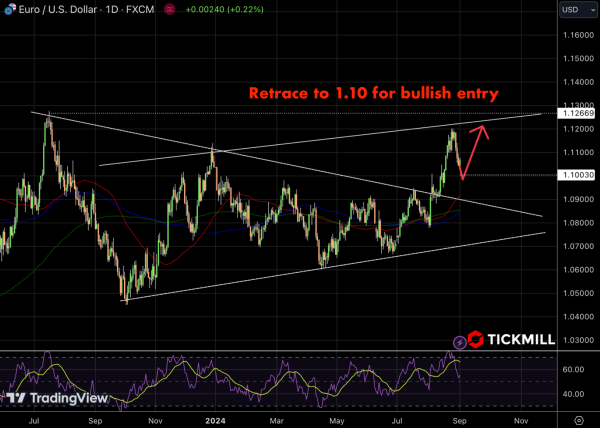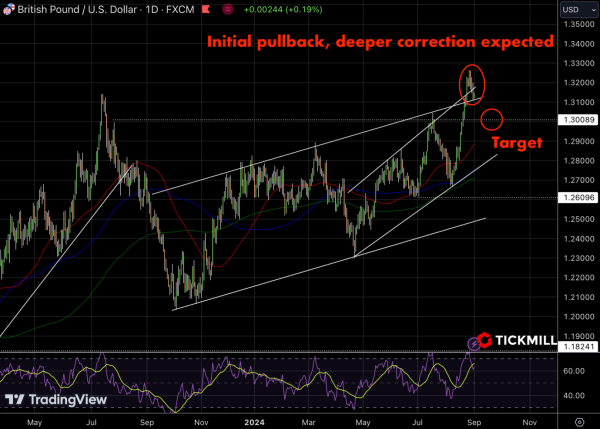EUR/USD Technicals Show Bullish Breakout, But Short-Term Pullback Possible
The EUR/USD pair is currently trading slightly higher, hovering around the 1.1070 mark. A key bearish factor weighing on the greenback is the growing anticipation that the Federal Reserve may significantly reduce interest rates in its upcoming September meeting. The potential for a sharp 50 basis point cut, bringing the federal funds rate down to a range of 4.75% to 5.00%, has been a hot topic among traders. The likelihood of this “mega cut” stands above 30%, as per interest rate derivatives, with a more modest 25 basis point reduction already fully priced in by the market.
The implications of such a rate cut are profound. Lower interest rates diminish the appeal of the USD to foreign investors, as they reduce the return on U.S. assets, leading to a decrease in capital inflows. This, in turn, applies downward pressure on the dollar, bolstering the EUR/USD pair.
EURUSD’s medium-term technical chart shows a strong bullish trend, recently breaking out of the wedge pattern. However, the short-term market state is definitely overbought, as indicated by the RSI, suggesting a potential pullback. A retracement to the 1.10 level, which aligns with previous resistance turned support, would offer a more favorable entry point for bullish trades. Holding above this level would confirm the continuation of the upward trend, targeting new highs towards the 1.12 region:

Contrasting with the Fed’s potential aggressiveness, the ECB is expected to proceed with caution regarding interest rate cuts. The Eurozone continues to grapple with persistent wage inflation, which suggests that higher interest rates might linger for a longer period. This expectation provides some support to the Euro, as the currency benefits from the relatively higher yield environment.
Recent inflation data from the Eurozone has been mixed. While preliminary CPI readings from Germany and Spain showed inflation declining more than expected, this initial weakness in the Euro was mitigated by the subsequent Eurozone-wide inflation data. Core CPI figures came in as expected, allowing the Euro to recover as it reaffirmed the ECB’s likely steady and measured approach to monetary easing.
While the PCE Price Index for July, a crucial measure of US inflation, remained flat, the spotlight now turns to upcoming employment data. The Nonfarm Payrolls report for August, due this Friday, is particularly significant. A strong labor market reading could ease fears of an economic downturn in the U.S. and potentially influence the Fed’s decision-making process.
The market remains in a state of flux, with traders keenly awaiting this data to gain a clearer picture of the US economic trajectory and the Fed’s likely response. Until then, the EUR/USD is expected to remain sensitive to any developments that could shift the perceived balance of risks between the two economies.
The British Pound is holding onto marginal gains as the European session unfolds. The UK’s latest PMI data for the manufacturing sector aligned with expectations, reinforcing the view that the Bank of England (BoE) will likely hold off on a rate cut at its September meeting. However, a 25 basis point reduction in November is almost fully priced in by the market.
The near-term technical picture of GBPUSD is showing signs of a potential deeper correction after an initial pullback from its recent highs. The price has broken below the upper trendline of the rising wedge, signaling a possible reversal. The target for this correction appears to be around the 1.3000 level, which aligns with previous support and the 50-day moving average. The RSI is turning down from overbought conditions, further supporting the likelihood of continued downside movement:
